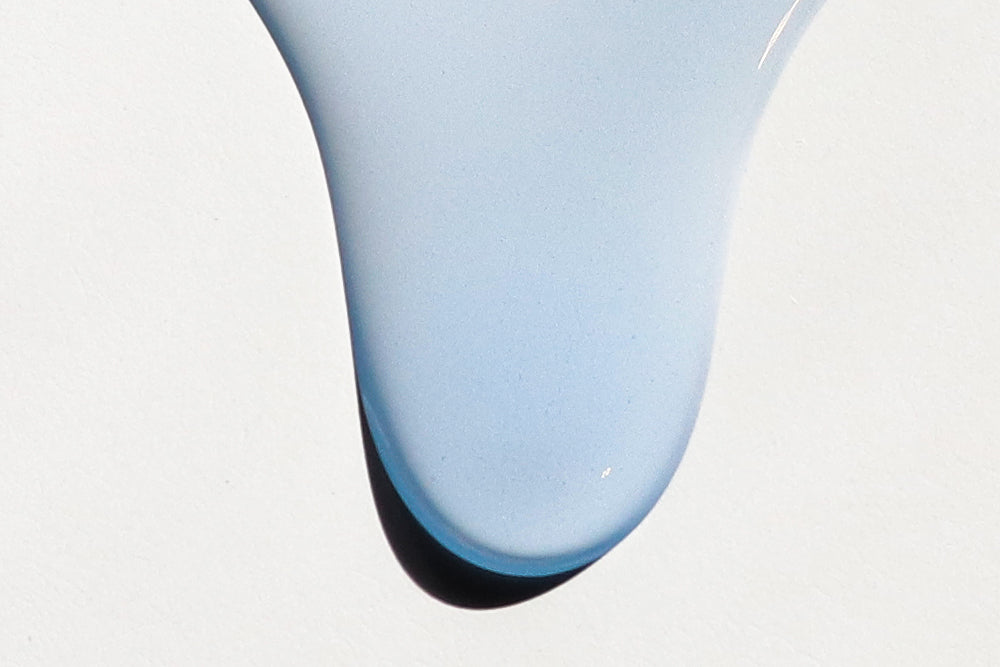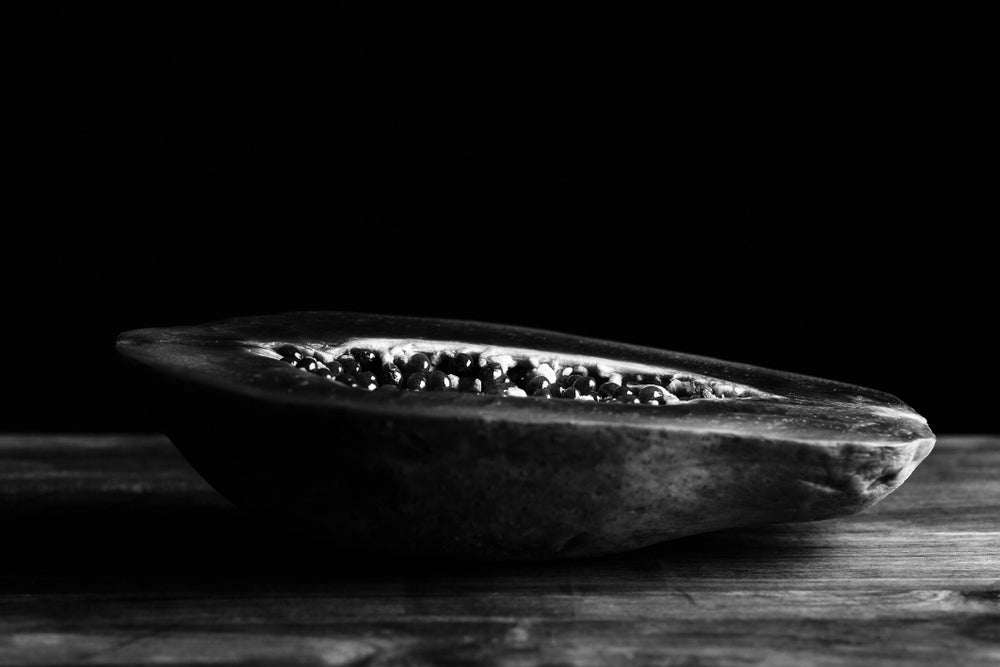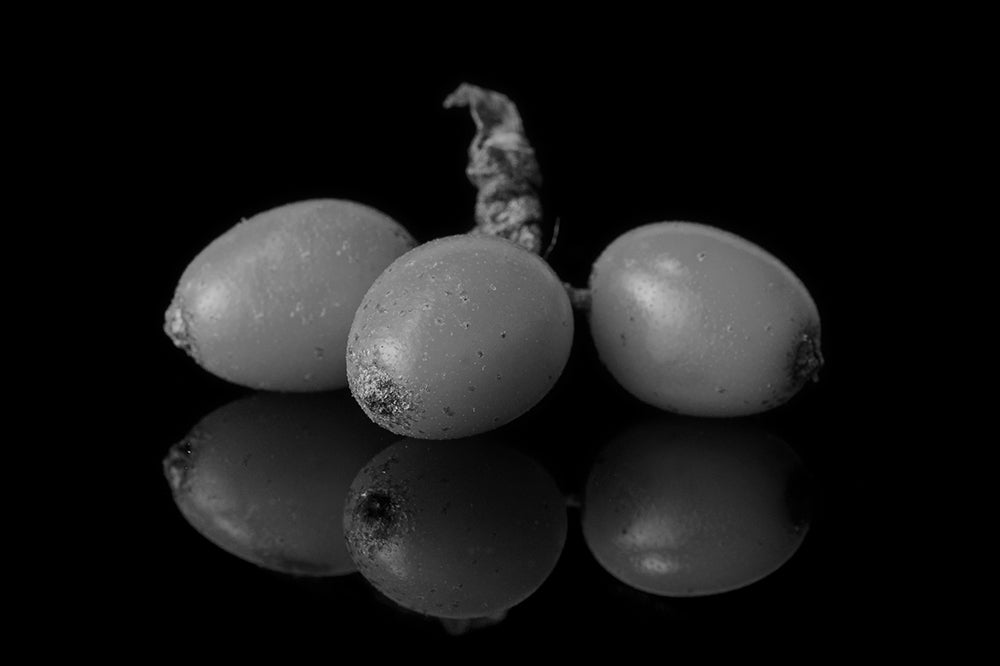
the color of skincare

the bottom line
The natural world holds an abundance of beauty for us. But did you know that the colors of natural ingredients can also provide us with a clue to their benefits? Blue, red/orange, yellow, and green – each shade has a tale to tell of the beauty beneath the stem. Blue oils are calming for the skin, while red oils stimulate regeneration and healing. Yellow oils are highly moisturizing and soothing, and green oils are helpful in the treatment of acne and inflammation. Read on for more about the intriguing role of color in skincare formulation.
first layer: the blues
Blue skincare products are easily some of the most striking ones on the market, with their sensual and hypnotizing shades and grounding scents. When researching emotional responses to the color blue, terms used have included “relaxed, at ease, calm, lovable”. And indeed, what’s not to love about a deep blue oil or balm?
Some noteworthy bluesy botanicals include blue tansy, blue chamomile, blue yarrow, blue cypress, and blue artemis. The vivid deep blue color of these oils stems from the presence of chamazulene, which is formed when the essential oil components released from the plant material are exposed to heat. These chamazulene-rich oils have been noted to bring cooling relief to irritated or inflamed skin, consistent with their color. Blue yarrow has been shown to have anti-inflammatory properties. It’s also been used to halt bleeding, to decrease menstrual cramps, and is a potent antioxidant*. While the scent of each oil varies slightly, the common element is a grounding, herbaceous fragrance.
Our own blue lotus body oil draws on the magnetic hue of blue yarrow essential oil, and its stable scent balances out the lighter yuzu oil. It’s a calming body oil for irritated, dry, and flaky skin. Cambrian blue clay is the hero of our blue clay clarifying masque which gently draws out impurities and exfoliates.
second layer: the green earth
The color green is associated with the earth and nature – cool, fresh, and fertile, with the potential for growth. There is a clearly grounding element to this color which carries over into the natural ingredients of the same hue. Green oils and powders tend to smell fresh and earthy, as in violet leaf, or oceanic, as noted with spirulina and seaweed. Green oils and ingredients tend to be especially useful in the treatment of acne and inflammation.
Some notable dark green essential oils include bergamot, violet leaf, green mandarin, green cognac, geranium, orange blossom, petitgrain absolute, black currant bud, black spruce, spikenard, oakmoss, and rosemary. Rosemary is an outstanding antioxidant and helps to prevent the growth of microorganisms. Bergamot is a fragrant citrus fruit which is the size of an orange, but which has a green color similar to that of a lime. Bergamot has antibacterial, anti-fungal, and antioxidant properties.
Anti-inflammatory, antioxidant, and anti-acne properties are found within the green carrier oils, including tamanu, avocado, olive, and blueberry seed. Tamanu has been shown to stimulate collagen* production in wound healing and exhibits antibacterial activity against Propionibacterium acnes and Propionibacterium granulosum, two bacteria which have been implicated in acne. Blueberry seed oil, which has a brilliantly bright green hue, is a potent source of antioxidants, carotenoids, and tocopherols, and is high in omega-3 fatty acids. Seaweed also acts as an antioxidant and anti-inflammatory while exfoliating, hydrating, and brightening skin. It’s able to regulate oil production of the skin, while some seaweeds have demonstrated a decrease in bacteria associated with acne. Green tea is a water-soluble antioxidant which can also reduce sebum production.
third layer: sunny yellow
The color yellow is traditionally associated with joy and light. Oils true to this sentiment include jojoba, sunflower, and safflower. Jojoba oil is technically a liquid wax ester extracted from seeds of the jojoba plant. The array of esters in jojoba is similar to those found in human sebum and helps to provide non-occlusive moisture.
Sunflowers are phototropic, meaning that they follow the sun. Indeed, the French word for sunflower is tournesol, which means “turn with the sun”. The oil derived from sunflower seeds is high in vitamin E and oleic acids, which makes the oil stable and resistant to oxidation. It is a highly effective humectant* and emollient*. Safflower seed oil is also rich in essential fatty acids, especially linoleic acid.
The brilliant yellow shade of our rice bran & pomegranate facial cleansing oil features a base of organic sunflower seed oil with rice bran oil and pomegranate seed oil. Designed for all skin types, our cleansing oil gently removes makeup and impurities from skin while hydrating and soothing.
fourth layer: fiery orange and red
Red – the color of passion, heat, and power - is found in both essential and carrier oils. Like the flowers and plants from which they are derived, the scents are often sweet and intense. The hue of red and orange oils stems from the presence of carotenoids*, which are yellow, orange, and red organic pigments produced by plants, algae, bacteria, and fungi. Carotenoids are also responsible for the color found in pumpkins, carrots, flamingos, and salmon. Red and orange oils show a tendency to be particularly useful in regeneration of the skin, including wound healing, scar treatment, improving skin texture and tone, and enhancing skin elasticity.
Essential oils with a reddish-orange hue include jasmine sambac absolute, lotus, rose absolute, calendula, pink lotus, orange blossom, champaca, red mandarin, and ruby red grapefruit.
Red-orange carrier oils include rosehip and sea buckthorn, both of which have elevated levels of carotenoids. Rosehip seed oil is notable for the presence of vitamins A, E, and the fatty acids omega-3, omega-6, and omega-9, which have been shown to regenerate and heal skin. In addition, rosehip oil serves as a highly effective emollient which improves skin barrier function, helps to brighten skin tone, and may improve skin elasticity. It’s also been found to be helpful in fighting acne secondary to its anti-inflammatory and anti-microbial properties. Sea buckthorn oil can be derived from either the fruit or the seed, although the concentrations of specific fatty acids differ slightly between the two. Both are rich in antioxidants, help to moisturize skin, and can improve skin tone, texture, and elasticity. Rosehip oil and sea buckthorn oil have been used in the treatment of scars and wound healing.
Coenzyme Q10, or ubiquinone, is an enzyme and potent antioxidant produced in the human body, with a bright orange color when isolated. It has demonstrated protection against free radical damage which in turn decreases collagen degradation. CoQ10 has been shown to stimulate the production of collagen and elastin in the skin which improves the appearance of fine lines and wrinkles. It also acts as a tyrosinase inhibitor which limits melanin production, thereby helping to prevent and fade skin pigmentation.
Our bakuchiol & pomegranate facial oil hosts a number of healing and regenerative oils and lipids, including pomegranate, rosehip seed oil, sea buckthorn seed oil, CoQ10, and bakuchiol. Created for mature and sensitive skin, this facial oil gently rejuvenates skin by helping to decrease the appearance of fine lines and wrinkles, reduce pigmentation, and alleviate acne.
All this and more at www.anokhaskincare.com .
Add a layer by joining our newsletter: http://bit.ly/anokha_layers
xx
anokha
references:
1. https://www.edenbotanicals.com
2. Rhind, JP. Essential Oils – A Handbook for Aromatherapy Practice, 2nd ed. London: Jessica Kingsley Publishers. 2012.
3. Schnaubelt K. Advanced Aromatherapy – The Science of Essential Oil Therapy. Fairfield: Healing Arts Press. 1998.
4. Yadav N, Chandra H. Suppression of inflammatory and infection responses in lung macrophages by eucalyptus oil and its constituent 1,8-cineole: role of pattern recognition receptors TREM-1 and NLRP3, the MAP kinase regulator MKP-1, and NFKB. PLOS One, 2017; 10: 1-19.
5. https://jeanne-blog.com/blue-oils-pt-1/
6. https://jeanne-blog.com/blue-oils-pt-2/
7. https://www.byrdie.com
8. Ranzato, E, Martinotti S, Burlando B. Wound healing properties of jojoba liquid wax: An in vitro study. J Ethnopharm 2011; 134: 443-449.
9. Meier L, Stange R, Michalsen A, Uehleke B. Clay jojoba oil facial mask for lesioned skin and mild acne – results of a prospective, observational pilot study. Forsch Komplementmed 2012; 19(2): 75-79.
10. Genena AK, Hense H, Junior HS, de Souza SM. Rosemary (Rosmarinus officinalis) – a study of the composition, antioxidant and antimicrobial activities of extracts obtained with supercritical carbon dioxide. Ciênc Tecnol Aliment 2008; 28(2): 463-469.
11. Valerón-Almazán P, Gómez-Duaso AJ, Santana Molina N, Garcia Bello MA, Carretero G. Evolution of Post-Surgical Scars Treated with Pure Rosehip Seed Oil. J Cosm Derm Sci App. 2015; 5: 161-167.
12. Pundir S, Garg P, Dviwedi A, et al. Ethnomedicinal uses, phytochemistry and dermatological effects of Hippophae rhamnoides L.: A review. Journal of Ethnopharmacology. 2021; 266: 113434.
13. Zielińska A, Nowak I. Abundance of active ingredients in sea-buckthorn oil. Lipids in Health and Disease. 2017; 16(1): 95-106.
14. Aruoma I, Halliwell B, Aeschbach R, Löligers J. Antioxidant and pro-oxidant properties of active rosemary constituents: carnosol and carnosic acid. Xenobiotica. 1992; 22:2, 257 268. doi: 10.3109/00498259209046624
15. Phetcharat L, Wongsuphasawat K, Winther K. The effectiveness of a standardized rose hip powder, containing seeds and shells of Rosa canina, on cell longevity, skin wrinkles, moisture, and elasticity. Clin Interv Aging. 2015; 10: 1849-56. doi:10.2147/CIA.S90092
16. Choi JS, Bae HJ, Kim SJ, Choi IS. In vitro antibacterial and anti-inflammatory properties of seaweed extracts against acne inducing bacteria, Propionibacterium acnes. J Environ Biol 2011; 32(3): 313-318.
17. Raharivelomanana P, Ansel J-L, Lupo E, et al. Tamanu Oil and Skin Active Properties: From Traditional to Modern Cosmetic Uses. OCL. 2018; 25(5): D5-4-509. doi:10.1051/ocl/2018048
18. Flores M, Saravia C, Vergara CE, Avila F, Valdés H, Ortiz-Viedma J. Avocado oil: characteristics, properties, and applications. Molecules. 2019; 24(11): 2172-2193.
19. Hseu YC, Ho YG, Mathew DC, Yen HR, Chen XZ, Yang HL. The in vitro and in vivo depigmenting activity of coenzyme Q10 through the down-regulation of α-MSH signaling pathways and induction of Nrf2/ARE-mediated antioxidant genes in UVA-irradiated skin keratinocytes. Biochem Pharmacol. 2019; 164: 299-310. doi:10.1016/j.bcp.2019.04.015.
20. Zhang M, Dang L, Guo F, Wang X, Zhao W, Zhao R. Coenzyme Q(10) enhances dermal elastin expression, inhibits IL-1α production and melanin synthesis in vitro. Int J Cosmet Sci. 2012; 34(3): 273-279. doi:10.1111/j.1468-2494.2012.00713.
definitions:
antioxidant: an antioxidant is a compound that inhibits oxidation. free radicals create oxidative stress and an inflammatory response which in turn can damage DNA and result in injury to the epidermal and dermal layers of the skin. in the skin, this manifests as premature aging with decreased elasticity leading to increased wrinkling, age spots, and decreased skin tone. antioxidants stabilize free radicals, which in turn limits their ability to damage the body. some of our favorite ingredients are notable for their antioxidant effects, including elderberry, plum, and lychee.
carotenoids: yellow, orange, and red organic pigments produced by plants, algae, bacteria, and fungi
collagen: a fibrous protein that forms part of the dermal matrix, connective tissue, cartilage, and bone
emollient: softens and soothes skin
humectant: retains or preserves moisture
for more beauty terms, visit the glossary.



leave us a comment
This site is protected by hCaptcha and the hCaptcha Privacy Policy and Terms of Service apply.